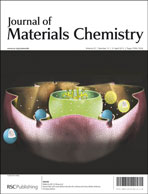The effect of microsized roughness in nano/microsized hierarchical surfaces replicated from a lotus leaf on the activities of osteoblast-like cells (MG63)
Abstract
One of the challenges in tissue engineering is the design of optimal biomedical scaffolds, which can be governed by both physical and chemical properties, such as structural properties (porosity, pore size, and tortuosity) and surface characteristics. Of these properties, we observed the effects of nano- to microsized hierarchical surface. To achieve the hierarchical surface structure on poly(ε-caprolactone) (PCL) film, we employed an electric-field-aided nano/micro-casting technique (FA-NCT) to mimic a typical natural hierarchical structure, the lotus leaf. The sizes of the microsized structures in lotus leaf replicas were controlled by employing or not employing the electric field during casting. The hierarchical surfaces showed two different roughness ranges for the microsized structure and the nanosized structure: (1) 1.7 ± 0.2 μm and 627 ± 163 nm and (2) 3.2 ± 0.3 μm and 635 ± 127 nm, respectively. To reduce the hydrophobicity in the replicated surfaces, they were coated with


 Please wait while we load your content...
Please wait while we load your content...